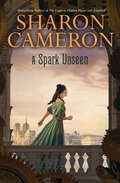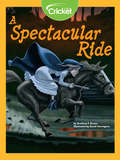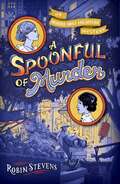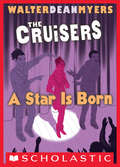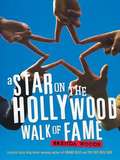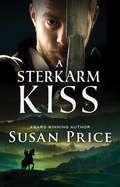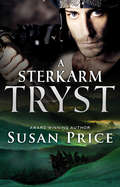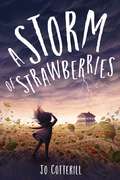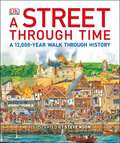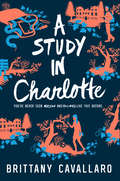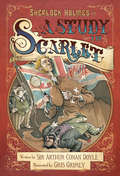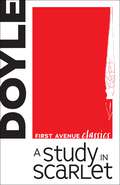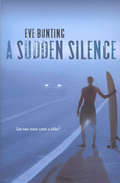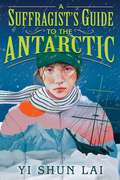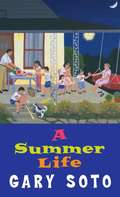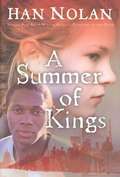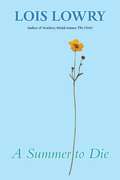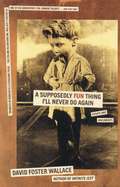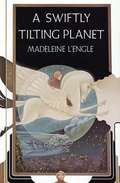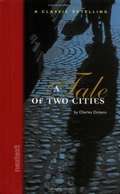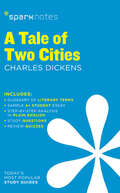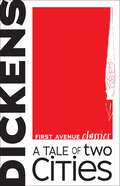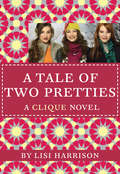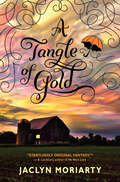- Table View
- List View
A Sound Move
by Linda MontoyaEddie Hernandez and his band have been invited to play in a festival. One member refuses to practice. Will the band be ready in time?
A Spark Unseen
by Sharon CameronFrom a New York Times–bestselling author, a historical suspense featuring a young woman who flees to Paris seeking the man she loves and suspects is dead.When Katharine Tulman wakes in the middle of the night and accidentally foils a kidnapping attempt on her uncle, she realizes Stranwyne Keep is no longer safe for Uncle Tully and his genius inventions. She flees to Paris, where she hopes to remain undetected and also find the mysterious and handsome Lane, who is suspected to be dead. But the search for Lane is not easy, and Katharine soon finds herself embroiled in a labyrinth of political intrigue. And with unexpected enemies and allies at every turn, Katharine will have to figure out whom she can trust—if anyone—to protect her uncle from danger once and for all.Filled with deadly twists, whispering romance, and heart-stopping suspense, this sequel to the award winning The Dark Unwinding whisks readers off on another thrilling adventure.
A Spectacular Ride
by Drollene P. BrownThe true story of a courageous teenage girl, Sybil Ludington, who rode 40 miles in one night on horseback to muster the militia in response to an impending invasion by British soldiers.
A Spoonful of Murder (A Murder Most Unladylike Mystery)
by Robin StevensHazel and Daisy find themselves embroiled in a mystery while in Hong Kong—and one of them winds up on the suspect list—in this gripping sixth novel of the Murder Most Unladylike Mystery series.When Hazel Wong&’s beloved grandfather passes away, Daisy Wells accompanies her best friend (and Detective Society vice president) to Hazel&’s family estate in beautiful, bustling Hong Kong. But when they arrive, they discover something they didn&’t expect: a new baby brother for Hazel! Hazel and Daisy think a surprise sibling is enough to be getting on with, but where they go, mystery always follows. And when tragedy strikes very close to home, this time Hazel isn&’t just the detective on the case… She&’s been framed for murder! Now the girls must work together to confront dangerous gangs, mysterious suspects, and sinister private detectives to solve the murder and clear Hazel&’s name before it&’s too late.
A Star is Born: A Star Is Born (The News Crew #3)
by Walter Dean MyersBestselling award-winning author Walter Dean Myers is back with a new book in his acclaimed Cruisers series.The Cruiser, an alternative newspaper published by Zander and his crew of middle school misfits, is alive and well. And now there's plenty to report on when LaShonda, one of the Cruisers, steps into the spotlight with her costume designs for an upcoming play. LaShonda's designs get rave reviews, but she soon learns that show business is filled with challenges and choices. LaShonda is forced to consider what's more important--fame, or loyalty to her autistic brother. Whether she gets a standing ovation or the curtain pulled down on her is up to LaShonda. And she can't help but wonder if the Cruisers have got her back and will be there for her whether she’s center stage or waiting in the wings. With signature humor and thought-provoking questions, Walter Dean Myers once again delivers a Cruisers novel that will keep readers at the edge of their seats, and have them applauding after the drama ends on the book’s last page.
A Star on the Hollywood Walk of Fame
by Brenda WoodsIf you could get a star on the Hollywood Walk of Fame for anything at all, what would it be? This writing assignment, given out in Ms. Hart's tenth-grade creative writing class, sparks a group of nine students each to tell his/her own story. Readers are introduced to Jake and Shante's interracial romance, Carlos' fear of deportation, and Sunday's determination after being sexually assaulted. These teens persevere through hardship and heartache, laughter and love, and in the end, their voices shine through inspiring journal entries that answer the question in unusual and unexpected ways. Once again, Brenda Woods shows a keen understanding of the teenage psyche, as she did in Emako Blue, winner of the 2005 IRA Children's Choice Young Adult Fiction Award. .
A Sterkarm Kiss (Sterkarm #2)
by Susan PriceAndrea gets a second chance on the sixteenth century side of the Time Tube--only to find that nothing changes more than the past. Having returned to the twenty-first century she was born into, Andrea Mitchell tries to forget her travels through time--and more specifically, her sixteenth-century lover, Per Sterkarm. She never felt at home in her own century, but it looks as though she's stuck with it. Then Andrea's former boss and enemy, James Windsor--executive of FUP, the corporation responsible for the creation of the Time Tube--offers her another chance to travel back to the past. She jumps at it, hoping to rekindle her romance with Per. But it's not the homecoming she had hoped for: Per doesn't know who she is. . . . It seems Windsor has found an alternate sixteenth-century Scotland, and there, Per is not quite the man Andrea fell in love with. Now, wrapped around Windsor's finger, the Sterkarms are on the verge of a bloody feud with their long-standing enemies, the Grannams. But Windsor's manipulations can't stand against the wiles and cunning of the Sterkarms. With Andrea's help, they will turn the tables on both the Grannams and the "Elves" from the future. Beware the Sterkarms! A Sterkarm Kiss is another thrilling tale in the award-winning Sterkarm series, perfect for fans of Outlander and Vikings.
A Sterkarm Tryst (Sterkarm #3)
by Susan PriceThe sixteenth-century Sterkarms are legendary warriors known for their cunning and strength--but what will happen when time travel sets them up to battle their counterparts in an epic final clash? James Windsor--leader of FUP, the twenty-first-century megacorporation that created a tunnel back to the past called the Time Tube--has no intention of giving up his plan to pillage resources from pristine sixteenth-century Scotland. Unfortunately for Windsor, the Sterkarm clan, who will do anything to protect their lands from invaders, continues to stand in his way. But if Windsor's modern-day mercenaries, with their technology, rifles, and rocket launchers, can't beat the primitive Sterkarm warriors, who can? And who could possibly understand the wild Scottish moors and the clan's brutal ways better than the Sterkarms themselves? When FUP opens up a new portal, two universes of Sterkarms are pitted against each other, but anthropologist Andrea Mitchell--originally sent back in time by FUP to study the clan--will risk her life to save Per, the warrior she loves, and the community she has grown to call home. And when both sets of Sterkarms become wary of the twenty-first-century "Elves," who shake on promises of friendship with one hand and commit murder with the other, they know there is only one way to protect their futures: join with the Grannams, and with each other, to destroy the tunnel, preventing the Elves from returning ever again. Perfect for fans of Outlander and Vikings, A Sterkarm Tryst is the epic conclusion to Susan Price's award-winning Sterkarm Trilogy.
A Storm of Strawberries
by CotterillTwelve-year-old Darby loves living on her family's strawberry farm. But a big storm is coming, and it threatens to destroy everything she and her family hold dear.Darby is twelve years old and has Down syndrome. Her favorite things are music, chocolate, and her big sister Kaydee. It's a big weekend for Darby. It's time for their annual chocolate hunt, and it's all she can think about. Well, that and spending time with her big sister. But this year Kaydee's friend Lissa is staying over for the weekend, and she seems to be stealing all of Kaydee's attention. And to make things worse, the strawberry farm is hit by a tornado. Suddenly, it's as though both the chocolate hunt and her sister are slipping away from her. Although the family is prepared for the tornado, they aren't prepared for the storm of emotions that surface when a truth is brought to light. With tension rising within the family, can Darby mend what's been broken when it seems like no one is listening to her? A Storm of Strawberries is a warm, thoughtful, and empathetic novel from acclaimed author Jo Cotterill.
A Street Through Time
by Dorling KindersleyThis book views a street by the river through the ages and how it has evolved.
A Study in Charlotte (Charlotte Holmes Novel #1)
by Brittany Cavallaro<p>The first book in a witty, suspenseful new trilogy about a brilliant new crime-solving duo: the teen descendants of Sherlock Holmes and John Watson. This clever page-turner will appeal to fans of Maureen Johnson and Ally Carter. <p>Jamie Watson has always been intrigued by Charlotte Holmes; after all, their great-great-great-grandfathers are one of the most infamous pairs in history. But the Holmes family has always been odd, and Charlotte is no exception. She's inherited Sherlock's volatility and some of his vices--and when Jamie and Charlotte end up at the same Connecticut boarding school, Charlotte makes it clear she's not looking for friends. <p>But when a student they both have a history with dies under suspicious circumstances, ripped straight from the most terrifying of the Sherlock Holmes stories, Jamie can no longer afford to keep his distance. Danger is mounting and nowhere is safe--and the only people they can trust are each other.</p>
A Study in Scarlet
by Arthur Conan Doyle Gris GrimlySir Arthur Conan Doyle's first novel--and the origin story of Sherlock Holmes and John Watson--is reimagined in the first unabridged, fully illustrated version since its debut, by acclaimed and bestselling illustrator Gris Grimly.The year is 1881. The city, London. A man lies dead in an empty house, not a mark upon him, and no clues--save for the word "RACHE" scrawled in blood on the wall above. Elsewhere, two men--a former army doctor called John Watson and a brilliant eccentric called Sherlock Holmes--meet for the first time. These two events set in motion an adventure into the darkest corners of men's hearts as the cold, calculating investigative methods of Mr. Holmes are put to the test in a case that spans decades and continents, rife with danger and intrigue.Originally published in 1887, A Study in Scarlet was the first novel to feature a character whose name would become synonymous with the art of deduction. Today it is completely reimagined with artwork by the modern master of gothic romanticism, Gris Grimly, bringing this thrilling tale of love and revenge to a new generation of readers.
A Study in Scarlet: A Sherlock Holmes Mystery (First Avenue Classics ™ #37)
by Sir Arthur DoyleDr. John Watson, recently returned from military service in Afghanistan, doesn't know what to make of his new roommate. Sherlock Holmes has profound knowledge of soil composition and sensational literature but knows next to nothing about contemporary politics and is ignorant of the fact that the Earth goes around the sun. Holmes hosts strange visitors at odd hours . . . and claims to be the world's only consulting detective. Soon Holmes and Watson are wrapped up in a mystery involving poison, a woman's wedding ring, and a word scrawled in blood. Will Holmes's science of deduction be enough to unravel the scarlet thread of murder? Taken from the 1887 copyright edition, this is an unabridged version of Scottish author Sir Arthur Conan Doyle's first Sherlock Holmes novel.
A Sudden Silence
by Eve BuntingJesse Harmon is tortured by guilt because he survived the hit-and-run accident that killed his brother, Bry. His guilt is compounded when he finds he is attracted to Bry's girlfriend, Chloe. Together Jesse and Chloe try to track down the drunk driver who killed Bry--but discovering the driver's identity leads to other disturbing truths.
A Suffragist's Guide to the Antarctic
by Yi Shun LaiA teen&’s fight for suffrage turns into one of survival when her crew&’s Antarctic expedition ship gets stuck in the ice in this historical novel told in journal entries perfect for fans of Gary Paulsen and The Downstairs Girl.November 1914. Clara Ketterling-Dunbar is one of twenty-eight crew members of The Resolute—a ship meant for an Antarctic expedition now marooned on ice one hundred miles from the shore of the continent. An eighteen-year-old American, Clara has told the crew she&’s a twenty-one-year-old Canadian. Since the war broke out, sentiment toward Americans has not been the most favorable, and Clara will be underestimated enough simply for being a woman without also giving away just how young she is. Two members of the crew know her nationality, but no one knows the truth of her activities in England before The Resolute set sail. She and her suffragist sisters in the Women&’s Social & Political Union were waging war of a different kind in London. They taught Clara to fight. And now, even marooned on the ice, she won&’t stop fighting for women&’s rights…or for survival. In the wilderness of Antarctica, Clara is determined to demonstrate what a woman is truly capable of—if the crew will let her.
A Summer Life
by Gary SotoGary Soto writes that when he was five "what I knew best was at ground level." In this lively collection of short essays, Soto takes his reader to a ground-level perspective, recreating in vivid detail the sights, sounds, smells, and textures he knew growing up in his Fresno, California, neighborhood. The "things" of his boyhood tie it all together: his Buddha "splotched with gold," the taps of his shoes and the "engines of sparks that lived beneath my soles," his worn tennies smelling of "summer grass, asphalt, the moist sock breathing the defeat of basesall." The child's world is made up of small things--small, very important things.
A Summer of Kings
by Han NolanIt's 1963 and fourteen-year-old Esther Young is looking for excitement. Cursed with a lack of talent in a family filled with artistic types, Esther vows to get some attention by initiating a summer romance with a black teen accused of murdering a white man in Alabama. King-Roy Johnson shows up on Esther's doorstep that summer, an angry young man who feels betrayed by the nonviolent teachings of Martin Luther King Jr. Sent north by his mother to escape a lynch mob, he meets a follower of Malcolm X's who uses radical teachings about black revolution to fuel King-Roy's anger and frustration. But with each other's help, both Esther and King-Roy learn the true nature of integrity and find the power to stand up for what is right and true. National Book Award-winning author Han Nolan brings readers a bold new voice--by turns funny and poignant, innocent and worldly--in this powerful coming-of-age story set during the turbulent struggle for civil rights.
A Summer to Die
by Lois LowryThirteen-year-old Meg envies her sister Molly's beauty and popularity, and these feelings make it difficult for her to cope with Molly's illness and death.
A Supposedly Fun Thing I'll Never Do Again: Essays and Arguments
by David Foster WallaceIn this exuberantly praised book - a collection of seven pieces on subjects ranging from television to tennis, from the Illinois State Fair to the films of David Lynch, from postmodern literary theory to the supposed fun of traveling aboard a Caribbean luxury cruiseliner - David Foster Wallace brings to nonfiction the same curiosity, hilarity, and exhilarating verbal facility that has delighted readers of his fiction, including the bestselling Infinite Jest.
A Swiftly Tilting Planet (A Wrinkle In Time Quintet #3)
by Madeleine L'EngleMeg Murry O'Keefe and her family are just sitting down to Thanksgiving dinner when her father gets a phone call from the White House about a madman's threat of nuclear war. Only an old Irish rune seems to hold a clue to averting worldwide disaster, and and when Meg's brother Charles Wallace, now fifteen, recites it, a radiant white beast--the unicorn Gaudior--appears to join him on his quest. But there are only twenty-four hours in which to stop tragedy from occurring. Can Charles Wallace, with the help of Gaudior and Meg, possibly succeed?
A Tale Of Two Cities: A Classic Retelling
by Charles DickensA Tale Of Two Cities: A Classic Retelling for High School students
A Tale of Two Cities SparkNotes Literature Guide (SparkNotes Literature Guide Series)
by SparkNotesA Tale of Two Cities SparkNotes Literature Guide by Charles Dickens Making the reading experience fun! When a paper is due, and dreaded exams loom, here's the lit-crit help students need to succeed! SparkNotes Literature Guides make studying smarter, better, and faster. They provide chapter-by-chapter analysis; explanations of key themes, motifs, and symbols; a review quiz; and essay topics. Lively and accessible, SparkNotes is perfect for late-night studying and paper writing. Includes:An A+ Essay—an actual literary essay written about the Spark-ed book—to show students how a paper should be written.16 pages devoted to writing a literary essay including: a glossary of literary termsStep-by-step tutoring on how to write a literary essayA feature on how not to plagiarize
A Tale of Two Cities: A Tale Of Two Cities Is A Historical Story Of The French Revolution By Charles Dickens (First Avenue Classics ™)
by Charles DickensAfter rescuing her father from prison in Paris, Lucie Manette brings him back home to London. There, she is wooed by two similar-looking men: Charles Darney is a Frenchman recently acquitted of being a spy, while Sydney Carton is a drunken lawyer's assistant. Eventually, Lucie and Charles marry. Not long after the French Revolution begins, Charles is called back to Paris to help someone in prison. Unfortunately, Charles is the nephew of a cruel nobleman, and the revolutionaries sentence him to death for his uncle's crimes. Sydney's love for Lucie may be the only thing that can save Charles's life. This unabridged version of Charles Dickens's classic tale, first published in England in 1859, explores the best and worst in human nature.
A Tale of Two Pretties (The Clique #14)
by Lisi HarrisonMassie Block has long led the Pretty Committee--through boy drama, clique mutinies, and jealous wannabe attacks--while always in ah-dorable outfits. Over the past thirteen novels, avid fans of Massie, Alicia, Dylan, Kristin, and Claire, have made The Clique one of the premier bestselling series in the world. After the myriad of juicy escapades, the Clique is finally ready for their curtain call. The Clique . . . the only thing harder than getting in is saying goodbye.
A Tangle of Gold: Book 3 Of The Colors Of Madeleine (The Colors of Madeleine #3)
by Jaclyn Moriarty“A grand finale to a grand adventure, complete with truly startling revelations . . . Colorful and madcap . . . deeply satisfying, perfectly ended.” —Kirkus Reviews (starred review)Cello is in crisis. Princess Ko’s deception of her people has emerged and the Kingdom is outraged; the Jagged Edge Elite have taken control, placing the Princess and two members of the Royal Youth Alliance under arrest and ordering their execution; the King’s attempts to negotiate their release have failed; Color storms are rampant; and nobody has heard the Cello wind blowing in months. Meanwhile, Madeleine fears she’s about to lose the Kingdom of Cello forever. Plans are in place to bring the remaining Royals home, and after that, all communication between Cello and the World will cease. That means she’ll also lose Elliot, now back in Cello and being held captive by a branch of Hostiles. And there’s nothing he can do to help his friends unless he can escape the Hostile compound.Worlds apart and with time running out, Madeleine and Elliot find themselves on a collision course to save the Kingdom they love, and maybe even save each other.“A breathless and exhilarating race to the finish . . . with a variety of unexpected revelations and marvelous surprises, and with [Moriarty’s] usual perfect timing.” —The Horn Book (starred review)“The magic continues to be refreshingly inventive, and the world-building is so precise . . . This final installment will garner even more followers.” —School Library Journal (starred review)“Startling and clever . . . A breathtaking climax . . . An eminently satisfying conclusion.” —The Bulletin of the Center for Children’s Books (starred review)

